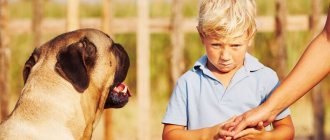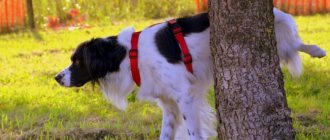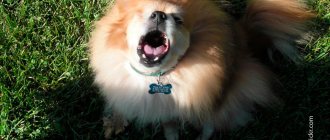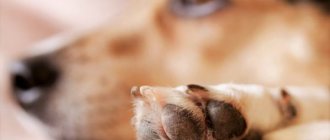Aggression, in itself, is considered the most important problem in relationships between people and dogs. But nothing causes such sharp rejection as dog aggression towards children.
Nothing fuels media hysteria and the resulting public fear and hatred more than cases of dog attacks on children. In this hysteria, the reasons that led to aggression are forgotten; there are simply no mitigating circumstances for the dog. Moreover, in the overwhelming majority of cases, the tragedy could have easily been avoided. Basic precautions and at least a minimum of knowledge about the psyche of dogs - and nothing bad would have happened.
It’s a pity, as strange as it may seem at first glance, almost half of the bites happen within the family. That is, when a dog bites not a STRANGER, but a FAMILIAR child. The forums are full of messages like: “The dog growls at the children, what should I do?” Or: “She rushed and bit the child in the face, for absolutely no reason, he just wanted to hug and caress her!”
The situations are standard, repeated over and over again, and, unfortunately, they usually end the same way: the dog is given away to other hands. This is the best case scenario. At worst, they are thrown away or euthanized.
Let's first find out the reasons: WHAT leads to manifestations of aggression in dogs towards children.
The main motives for any aggression are: fear, hunting instinct, protest and dominant aggression. Dog aggression towards children is no exception.
Let's take a closer look at these motives.
Fear
There is no paradox: a dog often bites because it is afraid. It's not just children who are afraid of dogs. It's not uncommon for dogs to be afraid of children - and not just nervous little dogs. By the way, they are justifiably afraid. For a small dog, the child still seems immeasurably larger than she is. In addition, children have a habit of screaming loudly, making sudden movements, running around stomping and squealing - this frightens dogs. In addition, especially young children are awkward, careless in play and, without meaning to, can seriously injure the dog.
Leaving children alone with a pit bull is very dangerous.
Especially for a pit bull. But large dogs can also be afraid of children for these reasons. In addition, even a dog that usually gets along with children without problems can show defensive aggression. A typical situation: the dog is sleeping, relaxed, and suddenly, the child runs up to the dog and literally falls on the sleeping dog, wrapping his arms around him. A dog, abruptly pulled out of sleep, makes an involuntary gesture of defense and... bites the child. The same reaction is caused by acute pain caused to a dog. Few people know that during an autopsy of a Rottweiler dog, euthanized after attacking its owner's child, the pathologist found a pencil pushed into the ear so that it pierced the middle ear and entered the brain through the inner ear. Journalists who were fanning hysteria around fighting breeds somehow forgot to mention this fact...
What to do
As you can see, dogs can bark at children for various reasons. The main reason is not always as clear as we would like. Since there are several possible causes at play, and barking can be a warning of the possibility of a future bite, it is best to consult a dog behaviorist for direct guidance. In the meantime, here are some general tips for dogs that bark at children.
- Make a list of circumstances that have caused your dog to bark at children in the past. Think through each event carefully and highlight the circumstances that could lead to the barking. Did the child run and play? Was your dog in the car? Was there barking when the child got too close to her?
- Prevent rehearsal of problem behavior through guidance. Management therefore involves preventing unwanted behavior from your dog. Thus, if you notice a tendency for your dog to bark, do not expose your dog to the same situation in the future. For example, if your dog barks at children playing in front of your house, keep windows and doors away so your dog doesn't feel obligated to bark. Out of sight, out of mind.
- Consult a dog behavior specialist for unlimited behavior modification for safety and proper execution. Describe the triggers you notice. The professional will suggest a plan based on the circumstances that are causing your dog to bark. For example, if your dog barks at the sight of children on a walk due to fear or lack of socialization, a “look at this” exercise applied to children in context may be helpful. The goal is to create positive associations in children.
- It also helps to eventually teach some type of "response substitution" where you ask the dog to perform an alternative behavior, such as sitting and looking at you when a child approaches, which triggers a fear response followed by a treat. This encourages your dog to look to you for instructions rather than react, and also creates a positive association.
- Use a basket muzzle if you are afraid that the dog may harm children. Children can jump out of nowhere and sometimes come up behind your dog and pet it, this can be a recipe for a bite. A muzzle can cover you.
- Finally, never leave children alone with a dog, even for a moment. Make sure you teach children to be respectful of your dog's space, and make sure your dog has a safe place to be alone. When you cannot actively supervise, keep the dog in an area where there is a physical barrier, such as a gate, between the dog and children (make sure children do not stick their hands or fingers through!)
Article Author: Adrienne Farricelli Adrienne is a certified dog trainer and behavior consultant, former veterinarian assistant, and author of Brain Training for Dogs.
Hunting instinct
In this case, the cause of dogs’ aggression towards children is the dogs’ natural instinctive desire to chase and attack fast-moving objects. Children running around screaming loudly and waving their arms greatly excite dogs. Especially, puppies and young dogs of temperamental, very active breeds are easily provoked into playful or even quite serious aggression if they see kids playing around. As a rule, in this case, aggression is not sharply expressed at first, but if the child does not pay attention to the dog’s nervousness or, on the contrary, shows a panic reaction, the aggression grows and can end in very serious bites.
Aggression of protest
The behavior of a dog in a pack is subject to certain rules. If these rules are violated by other members of the pack, and this violation infringes on the rights of the dog, it protests. Simply put, the dog protects its bone, bowl, toy, resting place from encroachment. If a dog meekly gives a bowl or toy to you, this does not mean that he will give it to your child just as meekly. Moreover, children (like puppies in a pack) have a lower position in the table of ranks than adult members of the community.
Protest occurs not only when protecting resources. By protesting, the dog makes it clear that your behavior towards it is unpleasant to it, and it does not intend to tolerate it. We are not talking only about actions that certainly cause pain or inconvenience to the dog. Under some circumstances, caresses can also be annoying - after all, people also believe that sometimes caresses are inappropriate. Dogs can (again, like people) express their dissatisfaction in different ways. Some endure it with a sour look, others begin to protest: grumbling and snapping. Unfortunately, the dog has little choice. In nature, an adult wolf can simply move away from annoying wolf cubs. But a dog tied to a chain or confined within the four walls of an apartment has no way to evade uninvited violators of its individual distance.
By the way, about the distance. Wolves and dogs, especially large working breeds, need to maintain the so-called individual distance. What does it mean? Unlike primates, many of whom in childhood are literally stuck to their relatives and in adulthood often sit hugging and clinging to each other, dogs maintain physical contact to a different extent. Little puppies sleep side by side. Adult dogs often sleep and rest at a certain distance from each other, without laying their heads on their companions or even touching. Unlike monkeys, the caresses of dogs are fleeting, gentle, without squeezing or hugging. Dogs also don't spend hours digging through each other's fur like our four-armed ancestors.
Dogs do not like intrusive, rough caresses with squeezing and patting. Especially if they are addressed to the dog at the wrong moment - when it is gnawing on a bone, sleeping, or resting. She does not perceive these caresses as caresses, but as violations of individual distance. If the individual distance is violated occasionally, a calm, socialized dog tolerates this relatively without stress. But if the distance is violated often, rudely and for a long time, discomfort increases, stress and irritation grows, and the dog begins to grumble and snap at the child. Growling has several functions, the main one being warning. You cannot punish a dog for warning of its intentions. If her protest is justified, punishment will only increase the dog's stress. Yes, maybe you will be able to suppress manifestations of discontent for a while. BUT irritation driven inside and finding no way out will one day burst out like a ripe abscess, and then a tragedy can occur...
Dominant aggression
In relation to adult people, dogs extremely rarely show dominant aggression, since they recognize the superiority of humans without objection. But in relation to children, dominant aggression, unfortunately, does not appear so rarely. As mentioned above, puppies in a pack and children in a family (no matter how unpleasant it may be for parents) are at the bottom of the ranking ladder and you cannot appoint them in charge over the dog by written order. It is simply the order of things: children must obey, elders must protect and teach them. And educate. Punishment is one of the moments of education, therefore, in a pack of wolves or dogs, an overly intrusive and impudent descendant can receive a slap on the head: a short bite, a blow with the teeth.
This applies to both protest and dominant aggression. In case of protest, the dog bites because the child touched its rights. For a hand that reached to a bone or caused pain; for a foot that stepped on a toy; for the stick with which the child was poking the dog. It's like nothing personal. With dominant aggression, the bite is directed towards the face. This behavior in itself does not carry any pathology, but... the dog does not realize one important thing: a human child is too fragile. The human body simply has a different margin of safety than the body of a predator created by nature for battle. In addition, most of our dogs raised outside of a full pack have socialization deficiencies. In particular, they lack the ability to dose aggression and limit themselves only to RITUAL aggression.
Let's go back to the beginning of the article. To a typical situation when a child, in the best of feelings, hugs a dog by the neck and... gets a bite in the face. It would seem that the innocence of the child and the meanness of the dog are evident... but... remember one thing: we and they speak different languages. Did you know that "YAMA" means "mountain" in Japanese?
What in primates is considered a gesture of affection and request for protection (hugs and squeezing), in dogs is a strongly dominant gesture, with a hint of aggression. When a child HOVES over a dog, wrapping his arms around the front of the chest or neck and at the same time PRESSING his FACE on the dog’s neck or head on TOP, without knowing it, he is showing an extremely provocative gesture for any dog that has the slightest bit of self-respect. A situation where one dog IS provoking another cannot end peacefully - only if the humiliated dog shows a posture of submission. When you allow such a gesture towards a dog, it tolerates it. But don't expect a confident adult dog to show a humiliating pose to your little child!
It is not for nothing that I analyze in such detail the aggression of protest and dominant aggression. In the case of bites out of fear or during a surge of the hunting instinct, there is at least some explanation and justification for the dog’s actions. In the case of protest behavior or the dominant aggression described above, most people cannot explain the dog’s reaction, see no reason for aggression, and label the dog “inadequate.”
Some, especially older dog handlers raised on theories of dominance, may feel their pride swell at the words “dog's rights” or “children in the family have an inferior position.” What about suppressing a dog, practicing obedience, harsh training!? Why put the dog in its place?!
How to stop a dog from attacking children
You might be interested in this - “Dog and child: how to raise”
First of all, it is necessary to explain to the dog owner the specific nature of the problem behavior, its relationship with the dog’s normal behavior and the reasons for the deviations. In this regard, it is advisable to discuss certain fundamental aspects of dog behavior. Often we are talking about problems that have existed for a long time, which become more serious over time if the dog is treated “normally”, that is, like other dogs. It is possible to agree that the occurrence of a problem can only be explained by the owner’s insufficient attention and mistakes made, only in some cases, even if most owners tend to see this as the reason and are ready to believe it from the very beginning.
Walking together can reduce your dog's aggressiveness.
Identifying and correcting misconceptions of animal owners
People think that treating animals well means treating them kindly and fulfilling their every desire. These misconceptions are often accompanied by common attitudes toward animals that contribute to the problem. Without proper adjustment, this may reduce the pet owner's willingness to accept suggested behavior correction methods.
In this case, we are often talking about a person’s established ideas about his dog, his actions and the general principles of keeping animals. Two conclusions follow from this:
- firstly, if you doubt the opinion of the animal owner on such important issues, then there is a danger of putting him in a situation of severe psychological discomfort. Therefore, the consultant must be very tactful in attempting to correct such views. It is better to explain the mistakes made using the example of third parties. If the animal owner is persistent, then the consultant must be persistent, while remaining polite.
- The second and most important conclusion is that these established opinions, standing in the way of a successful resolution of the problem, are difficult to change. Thus, when two male dogs fight, their owners, as a rule, stand up for the weaker one, even if his behavior caused the problem situation to arise. As a rule, they cannot sympathize with the aggressor, since this contradicts their democratic beliefs and parental instincts. Moreover, as mentioned in Chapter 2, it can be almost impossible to convince some owners to stop treating their aggressive dogs like little children, as such advice would shake the foundations of their beliefs about what good animal ownership means. .
And yet, this is precisely what needs to be focused on during the consultation. Without changing such views and ideas that prevent a person from reconsidering his attitude towards a dog, even the most effective behavior correction method may fail due to unwillingness or incomplete willingness to cooperate.
Whether a dog is trained or not, it is simply not capable of reliably and accurately assessing who and when to bite and who not to bite. Thus, the responsibility always lies entirely with the owner. It is he who must constantly and carefully calculate the dog’s possible reactions in everyday situations and restrain the animal if there is any chance that the dog will show aggression where there is no real danger.
Stress strains relationships
We all know that when irritated and under stress, we often break down, make decisions that we regret and commit actions for which we are later ashamed. Dogs are not wired differently. And they, being under stress, become irritated and behave inappropriately to the situation. Having a baby in the house is very stressful for most dogs. Especially for a dog, who before this was the only “child” in the family and was loved and pampered, and after the birth of the child was abruptly pushed into the background.
In this situation, the dog experiences the same emotions that the eldest child of the family experiences with the arrival of the baby. Don’t think that the dog is smart enough to compare obvious things: the appearance of a child in the room and his eviction into the corridor. And she, just like us, is characterized by jealousy when no attention is paid to her, and the baby is surrounded with affection and care. And if parents at least try to explain the situation to older children (to be honest, this doesn’t help much), then the dog is simply sent away.
In addition, a small child in the house is often noisy, screaming, and running around. The dog, accustomed to peace and quiet, is irritated and tired no less than its owner. Dogs live faster than us, their metabolism is more active, they need twice as much time to regenerate the body - for rest and sleep. Especially if the dog is unhealthy, if the dog is not young. If a dog chronically does not get enough sleep, it becomes nervous and irritable. Walks, where she could relax and relieve stress, become shorter due to the busyness of her owners. If jealousy is also added to this, it doesn’t take much to release aggression. The behavior actually becomes inadequate: the strength of the protest does not correspond to this specific situation. Autonomic stress reactions also appear: a well-mannered and clean dog begins to mark in the house, chew things, lick and bite the hair on its paws down to bare skin.
The process of re-education
No matter what causes a dog to growl at its owner and other family members, such behavior must be dealt with. After all, according to statistics, about 80% of pets that allow themselves to behave this way are capable of biting a person.
If anger is not associated with a disease of the central nervous system, injuries or other pathological conditions, then you should start raising the presumptuous pet.
When working with overly aggressive dogs, experts recommend using an ultrasonic whistle. Its sound is so unpleasant to the ears of animals that the dog stops growling and grinning, just so as not to hear it anymore.
Gradually, he will begin to understand that his influence is associated with inappropriate behavior and will understand who is in charge in the house. In this case, the necessary reflexes are triggered.
When choosing re-education methods, you must take into account the type of aggression, habits and temperament of your pet. And if such behavior occurs in serious, large dogs, then it is best to contact a dog handler who knows the breed characteristics and has experience working with such dogs.
A large, strong pet is a big responsibility and it’s not worth risking the health of yours and your loved ones.
But, regardless of the size of the pet, it is important for the owner to restore his authority by becoming a real leader. The dog, of course, will not immediately accept the new state of affairs and will resist, but by showing patience, endurance and fortitude, the person will be able to normalize the situation.
Otherwise, a dog of a guard or fighting breed may become a threat to others. And if a person initially does not have a strong character and does not have experience in communicating and raising such animals, then the idea of having such a pet should be immediately abandoned.
To restore the hierarchy, it is important for the owner to know the leverage points and take control over them. This includes the process of feeding, affection, reward and punishment.










